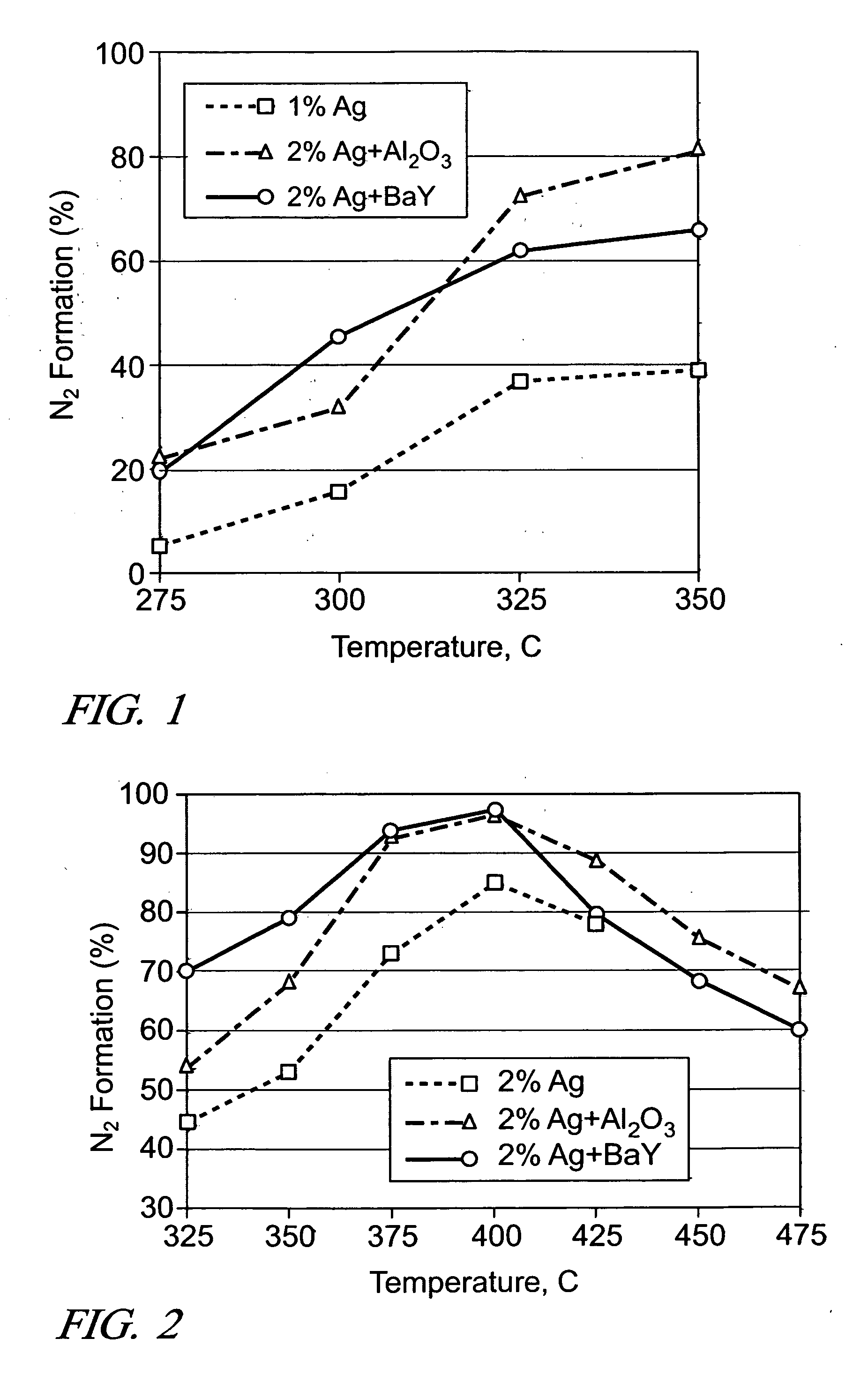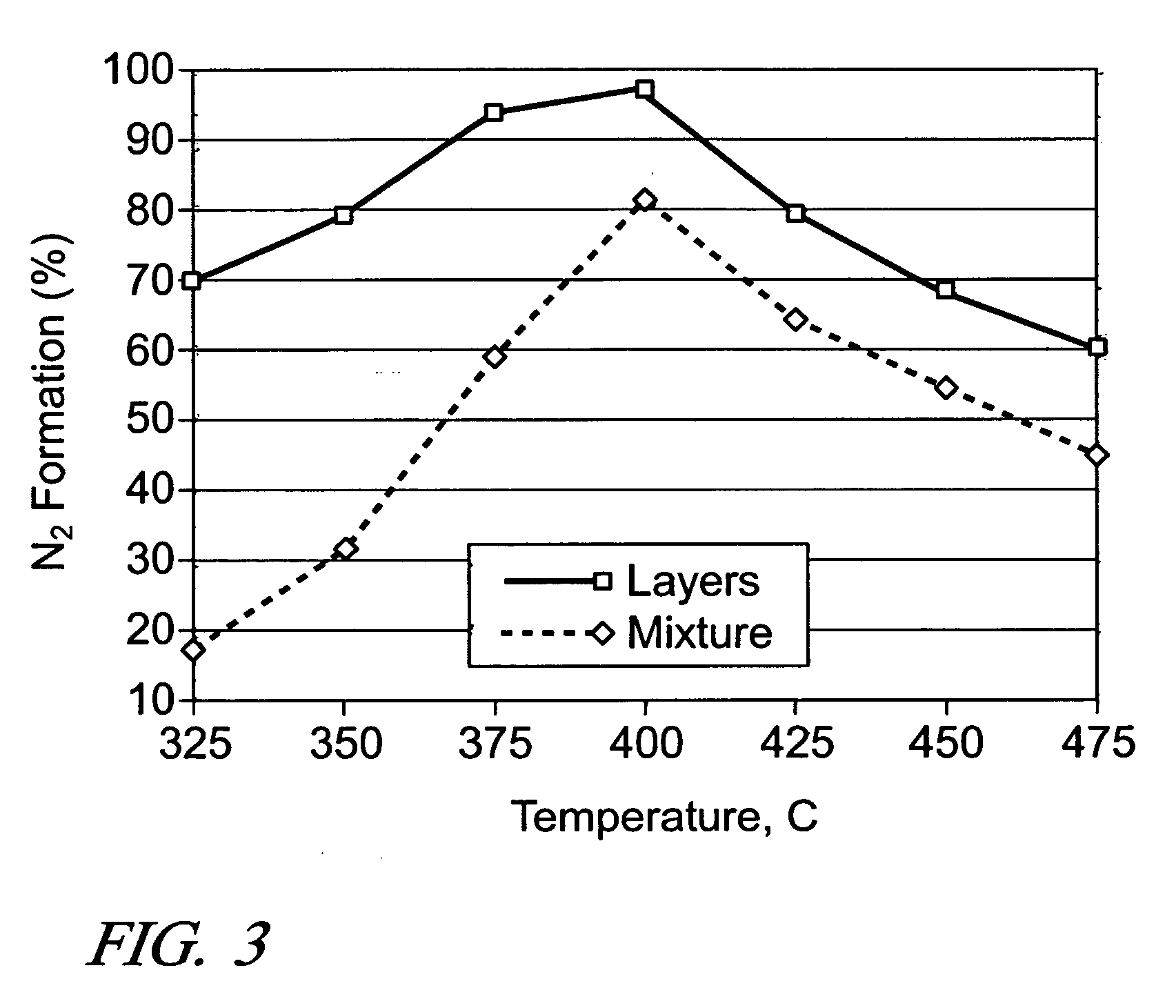Reduction of NOx emissions using a staged silver/alumina catalyst system
a catalyst system and silver/alumina technology, applied in physical/chemical process catalysts, arsenic compounds, separation processes, etc., can solve the problems of difficult reduction to nitrogen, catalyst development has not been successful, and traditional three-way catalysts used with stoichiometric gasoline engines are not very effective for treating lean-burn exhaust. , to achieve the effect of low cos
- Summary
- Abstract
- Description
- Claims
- Application Information
AI Technical Summary
Benefits of technology
Problems solved by technology
Method used
Image
Examples
example 1
[0029] Three different catalyst layouts, which contained the same amount of Ag and either Al2O3 or BaY, were prepared: (A) 0.12 g of 1 wt. % Ag / Al2O3, (B) 0.06 g of 2 wt. % Ag / Al2O3 followed by 0.06 g of Al2O3, (C) 0.06 g of 2 wt. % Ag / Al2O3 followed by 0.048 g of BaY. The amounts of catalysts were selected so the space velocity of the gas, was at 100 k h−1 for each catalyst bed (in this case of a quartz tube packed with catalyst powder). In this, first series of experiments, 1200 ppm ethanol was added to the gas stream (500-ppm NO, 15% 02, 10% H2O2He) as the “hydrocarbon” additive. The tests were conducted with the catalyst layouts at temperatures of 275° C., 300° C., 325° C., and 350° C., respectively.
[0030] During the reduction of NO by ethanol at 100 k h−1, similar % ethanol conversion was obtained for all three layouts. Ethanol conversion lit off slightly faster with the layered catalyst configurations (i.e., Layouts B and C) as Ag particles were concentrated in the front part...
example 2
[0032] The reduction of NO by n-octane addition to the exhaust was conducted for the following catalysts: (A) 0.06 g of 2 wt. % Ag / Al2O3 (200 k h−1), (B) 0.06 g of 2 wt. % Ag / Al2O3 followed by 0.06 g of Al2O3 (100 k h−1), (C) 0.06 g of 2 wt. % Ag / Al2O3 (100 k h−1) followed by 0.048 g of BaY. When the silver catalyst was used alone (A), an amount was-provided for a higher space velocity-(i.e., 200 k h−1) because the light-off temperature for n-octane was, found to be too low with the 1 wt. % Ag catalyst to obtain a fair comparison with the staged catalysts (B) & (C).
[0033] The n-octane conversion reaction lit off at similar temperatures over catalysts A and B as the same amount of Ag was used in the front part of the catalysts. However, as seen in FIG. 2, the % N2 formation was significantly improved over when additional Al2O3 was placed downstream of the Ag catalyst (i.e., Layout B). Interestingly, neither NH3 nor HCN were observed with the additional Al2O3. On the other hand, the ...
example 3
Ag / Al2O3+Variable Amount of Al2O3
[0034] It is expected that there would be an optimum ratio between the amounts of Ag / Al2O3 and a secondary catalyst. So, the effect of Al2O3 amount was examined by using two different amounts of Al2O3 (0.06 g and 1.5×0.06 g), while keeping the amount of 2 wt. % Ag / Al2O3 fixed at 0.06 g (i.e., 200 k h−1). During the NO reduction by ethanol, the increase in Al2O3 amount resulted in only slightly higher levels of NOx conversion and N2 formation at 275-350° C., and the same conversion levels at 425-500° C. For the NO reduction by n-octane, practically the same conversion levels were obtained at all temperatures, indicating the diminishing return of using additional Al2O3 in the layered configuration.
PUM
| Property | Measurement | Unit |
|---|---|---|
| temperature | aaaaa | aaaaa |
| temperature | aaaaa | aaaaa |
| temperatures | aaaaa | aaaaa |
Abstract
Description
Claims
Application Information
 Login to View More
Login to View More - R&D
- Intellectual Property
- Life Sciences
- Materials
- Tech Scout
- Unparalleled Data Quality
- Higher Quality Content
- 60% Fewer Hallucinations
Browse by: Latest US Patents, China's latest patents, Technical Efficacy Thesaurus, Application Domain, Technology Topic, Popular Technical Reports.
© 2025 PatSnap. All rights reserved.Legal|Privacy policy|Modern Slavery Act Transparency Statement|Sitemap|About US| Contact US: help@patsnap.com


